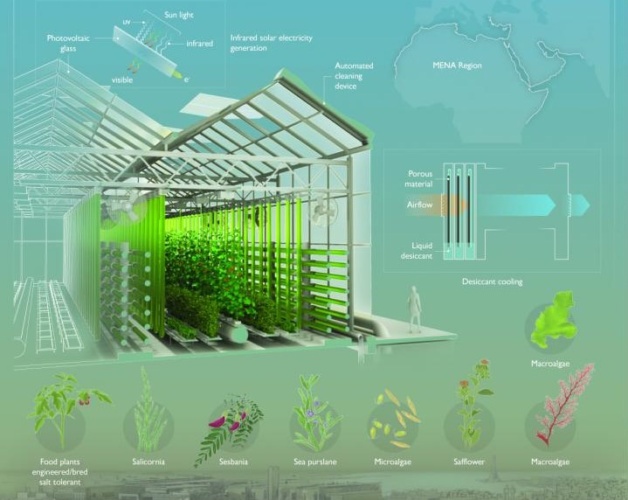
This is the view of KAUST researchers in Saudi Arabia who are calling for a new generation of vast greenhouse complexes, supported by novel solar panels, air-cooling technologies, and advances in salt-tolerant agriculture.
High hopes for UK vertical farming startup
Floating deep farms promise year round production of food crops
"Controlled environment agriculture (CEA) uses integrated systems to facilitate sustainable, local crop growth on a large scale," said Kyle Lauersen, synthetic biologist. "Our vision combines several technologies currently in development at KAUST: energy-efficient, transparent solar panels; low-energy desiccant cooling; salt-tolerant edible plants; and algal biotechnology."
Coastal locations in the MENA region have sufficient access to seawater and year-round intense sunlight. CEA makes it possible to use seawater to use grow salt-tolerant crops, such as newly identified varieties of tomatoes and green vegetables. Mixed irrigation means that CEA would have a lower impact on municipal supplies. To source extra freshwater, the researchers plan to harvest it from humid air.
"We are excited by developments in cooling technologies that leverage liquid desiccants," said research scientist Ryan Lefers. "Desiccants are highly concentrated substances that absorb water from the air. When humid air is pumped through a liquid desiccant system, it uses a highly saline liquid solution to absorb the moisture."
According to KAUST, the air released by the system is drier and cooler and can be circulated in the greenhouses, while the captured freshwater is recovered. The build-up of excessive heat inside greenhouses is a major concern in the MENA region. One solution comes from KAUST start-up iyris, which uses semi-transparent solar panels as windows. The panels allow visible light through for plant growth, while converting infrared energy into electricity.
The researchers also hope to combine plant and algae growth to generate biomass feedstocks for aquaculture, animal feed, chemical industry products and bioplastics.
"We see incredible potential for regionally inspired mixtures of salt-tolerant and freshwater species in different facilities, depending on market demands," Lauersen said in a statement. "It's becoming increasingly important to produce food and products in closer proximity to communities that need it. CEA will also provide food security, jobs and an economic base for year-round exports."
"This is where multidisciplinary research comes into its own," said plant scientist Mark Tester. "A pilot CEA greenhouse is under construction at KAUST as part of our spin-off company Red Sea Farms, and we will collaborate with colleagues across the university and beyond to demonstrate the exciting potential for CEA."
A paper titled ‘Emerging Technologies to Enable Sustainable Controlled Environment Agriculture in the Extreme Environments of Middle East-North Africa Coastal Regions’ has been published in Plant Science.





Nanogenerator consumes CO2 to generate electricity
Whoopee, they've solved how to keep a light on but not a lot else.